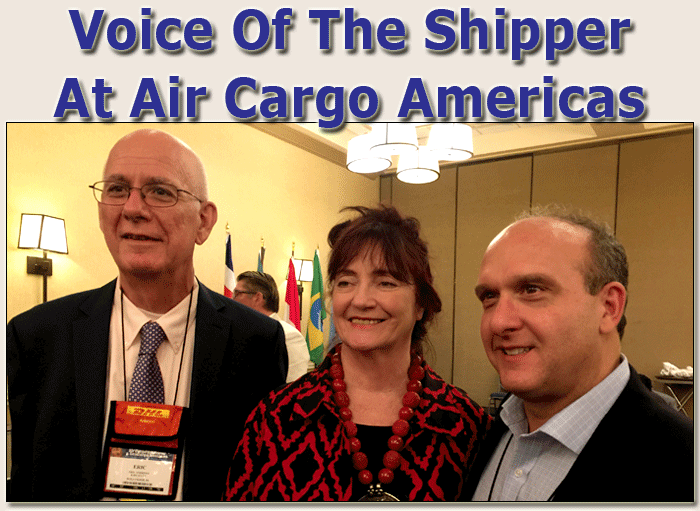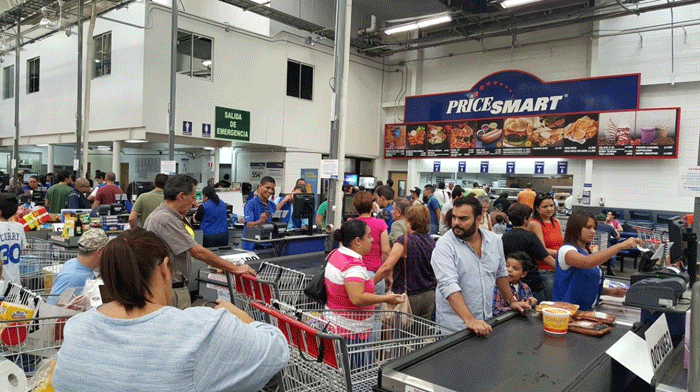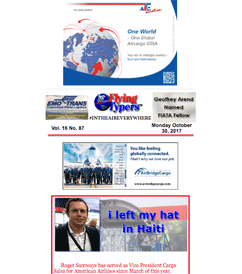
At Air Cargo Americas PriceSmart, Inc.
Executive Vice President of Logistics and Distribution Frank Diaz
delivers an eye-opening address. Pictured with Mr. Diaz (right)
is Charlotte Gallogly, President World Trade Center Miami and Eric
Andrews, President EMO 24 LLC.

PriceSmart In Barranquilla.
|
PriceSmart, Inc.
Executive Vice President of Logistics and Distribution Frank Diaz delivered
a rousing address at Air & Sea Cargo Americas on Wednesday, discussing
the rise of e-commerce and its impact on cargo.
“The landscape of retail is constantly
changing,” Frank Diaz declared, “and at a rapid rate.
“Almost daily now there are news
reports about disruption of retail, and bankruptcies.
“Store closures, zombie malls, and,the
‘Amazon Effect’ all dominate retail news headlines.”
Shifting
Customer Preference
“Traditional brick-and-mortar retailers,”
Frank Diaz insists, “appear under attack with massive disruptions,
but a closer look reveals that e-commerce retailers (albeit some more
aggressively than others) have only capitalized on evolving consumer preference
changes that favor shopping online.
“By focusing on customer-centric
solutions to the shopping experience and offering features like mobile
access, competitive pricing, the convenience of 24/7 access to shopping,
large selections, quick delivery, and free shipping, e-commerce retailers
have changed the overall landscape for retail, raising the bar for all
of us.”
Disruption
Versus Distortion
“So is it disruption
or distortion that is the reality here?
“Take the oft- noted e-commerce baseline
offer of free shipping.
“I was raised with the understanding
that ‘nothing is free’ and there is ‘no free lunch.’
“So when it comes to the purchase
of anything, clearly someone is paying for the costs of shipping.
“Having started my career in the
parcel delivery industry (that ironically once viewed residential delivery
unfavorably) shipping obviously cannot be free.
“The disruption,” Frank Diaz
points out, “is really in the challenge presented to retailers.
“For this example in the logistics
field we need to deliver goods faster and cheaper.”
Hold On To Your Hats
“In my view, there
has never been a more exciting time to be in the logistics industry.
“Gone are the days where logistics
was synonymous with simply warehouse and truck only adding costs.
“Now, in many cases logistics decisions
(now more broadly viewed as supply chain management) are cornerstones
of business strategy and competitive advantage in the marketplace.
“This raises the importance of our
‘disruption’ challenge, which will not go away; in fact, it
will expand as e-commerce expands (along with its disruptions) beyond
Business-to-Consumer and deeper into Business-to-Business relationships.”
Cross Border Growth Booming
“I believe the future
is bright, particularly with cross-border e-commerce throughout the Americas.
“The combination of an expanding
middle class (World Bank estimates that the middle class now represents
30 percent of the population across the region), increasing penetration
of smart phone use (the preferred method of shopping for online), improving
infrastructures and warehousing availability, and relative geo-political
stability are drivers forming a good foundation for cross-border e-commerce
to grow.”
Growth
Vision To 2020 Is 25 Percent
“Some estimates
put cross-border growth annually at 25 percent through 2020, impacting
mostly air cargo volumes, although I believe that there is opportunity
for ocean cargo as well,” Frank Diaz said.
Technology
Leads The Way
“With e-commerce,
complementing a technology platform, product assortment, and payment methods
join with an effective and efficient logistics system as key components.
“Covering the ‘first-mile’
through to the ‘last-mile,’ you should never forget that the
focus will be on reliability with faster and cheaper logistics.”
A
Matter Of Perception
“While these words
might not sound strange coming from a retailer, shipping rates are important.
“Saying ‘It’s not only
just about the rates’ might indeed raise some eyebrows.
“Taking a ‘net landed cost’
view to logistics costs and subsequently processes will offer ways to
drive costs down and reliability up.
“With cross-border e-commerce, it’s
international logistics.
“Unlike domestic e-commerce (as practiced
in the U.S.), the international process is more complex with more hand-offs
and interdependencies between parties and sub-processes that add time
and costs.
“This in effect makes entry difficult,
but offers opportunities for carriers, integrators, and freight forwarders
to innovate process-based solutions that increase speed and reliability
and remove costs from the system.
“For example, considering that e-commerce
shipments are generally small, air and ocean carriers should (as part
of the first-mile) expect and prepare for an increased demand for origin
consolidation services that later (as part of the final-mile) should be
complemented by detailed shipment visibility, speed of shipment deconsolidation,
and clearance and delivery with lower total landed costs.
“While these challenges are not easily
resolved, perhaps a customer-centric effort toward improving the customer
experience is our collective path to take.”
New
Industrial Revolution
“E-commerce is our
today; so what’s on the horizon for tomorrow?
“Nothing less than the future of
freight is on the line.
“We are in the midst of a new industrial
revolution that our industry needs to address.”
Who
Is PriceSmart?
PriceSmart is a retailer
that offers a membership shopping experience using the warehouse-club
format. It has served Latin America and the Caribbean for just over 20
years now.
Unique amongst U.S. retailers, PriceSmart
is based in the United States with retail stores (or “clubs”)
in 13 countries and generating essentially all of sales offshore.
PriceSmart leadership and innovation dates
back to the mid-1950s, when the legacy company began as FedMart (1954)
and later became PriceClub in 1976.
Father and son team Sol and Robert Price
pioneered the concept and warehouse-club retail industry with their first
location in San Diego, California. The idea was simple: operate a highly
efficient bulk-packaged retail and distribution business model that offers
high-quality products and services at every-day low prices in return for
a membership fee.
Today the Price family concept is viewed
as having ultimately laid the foundation of an over $200 billion retail
industry segment. Familiar names like Costco, BJ’s Wholesale, and
Sam’s Club can thank PriceSmart for their business model.
In fact, it was the merger of PriceClub
and Costco in the mid-1990s that in large part formed the industry leading
to the Costco that we know today.
A World View
“PriceSmart focused
on emerging markets around the world, beginning with various ventures
in Asia-Pacific that ultimately we divested from. It eventually found
great acceptance and ultimately success in Latin America and the Caribbean
for the warehouse-club format.
“Today, our merchandise offering
is comprised of a mix of imported and products.
“PriceSmart operates 40 warehouse-clubs
in 13 countries with approximately 3 million cardholders and $2.9 billion
in sales.”
Geoffrey |





